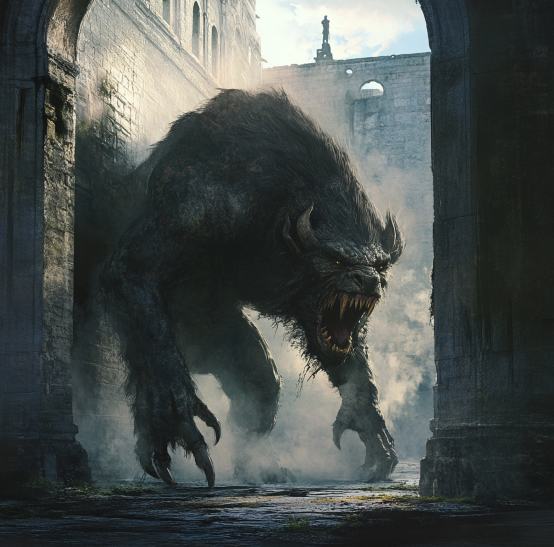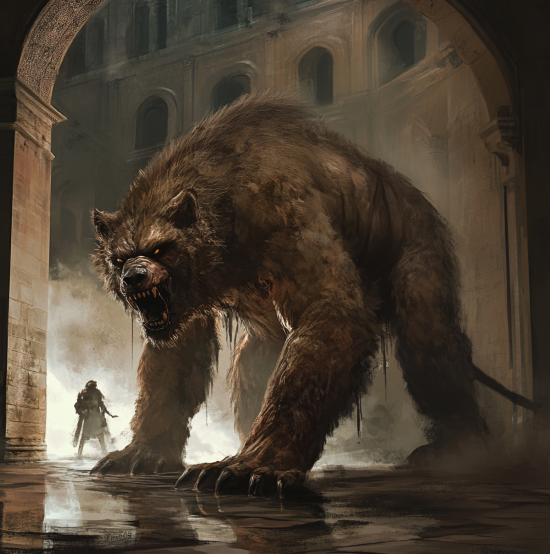The Beast of Gévaudan is a tale that has intrigued and terrified for centuries. This mysterious creature reportedly stalked the rugged terrain of the Gévaudan region in the 18th century, leaving a trail of fear and speculation in its wake.
Between 1764 and 1767, the beast was said to have brutally attacked both livestock and humans, amplifying the already prevalent fears of the unknown.
During this time, France was on the cusp of the French Revolution, a period marked by significant social and political upheaval.
The rural, agrarian communities of France, including those in Gévaudan, were steeped in superstition and folklore, creating a fertile ground for the legend to flourish.
Isolated by dense forests and challenging terrain, the region’s residents found themselves at the mercy of both the beast and their imaginations.
Unraveling the Origins
The tale of the Beast of Gévaudan began in 1764, when the first attacks were reported in the remote region of Gévaudan, now part of modern-day Lozère in southern France.
The beast allegedly appeared in summer, preying on livestock and people alike, with eyewitnesses describing a creature unlike any known animal.

Gévaudan was characterized by its rugged landscapes and dense forests, providing a perfect backdrop for something as elusive and mysterious as the beast. The region’s isolation and natural barriers only amplified the sense of dread, as news of the attacks spread rapidly through the countryside.
During this time, the cultural environment of Gévaudan was heavily influenced by superstition and folklore. The populace, familiar with tales of wolves and mythical creatures, found themselves trying to make sense of the beast through the lens of existing legends and religious beliefs.
This combination of geographical isolation and a rich tapestry of local myths set the stage for the beast to become an enduring enigma.
Accounts and Descriptions
The story of the Beast of Gévaudan is steeped in mystery, with no documented eyewitness testimonies readily available to capture its terrifying presence.
Despite the absence of firsthand accounts, historical records from the 18th century provide detailed descriptions of this enigmatic creature.
According to these records, the beast was often depicted as a large, wolf-like animal with striking features:
- Size: The beast was said to be larger than a typical wolf, with some describing it as being as big as a calf.
- Appearance: It featured a long, muscular body, a large head, and a wide mouth filled with sharp teeth. Its fur was often noted as reddish-brown or grayish in color.
- Behavior: Known for its aggressive nature, the beast attacked both livestock and humans, demonstrating incredible speed and agility.
- Eyes: Some accounts spoke of its glowing eyes, which added to its fearsome reputation.
- Teeth: Witnesses frequently mentioned the beast’s large, sharp teeth, capable of inflicting severe injuries.
These descriptions, while varied, consistently highlight the beast’s imposing size and ferocity, leaving an indelible mark on the historical and cultural fabric of Gévaudan.
Impact on the Community
The presence of the Beast of Gévaudan cast a long shadow over the region, instilling profound fear and panic among its residents. As reports of attacks spread, an atmosphere of dread took hold, disrupting daily life and routines.
People were often too afraid to venture outside, especially at night, which led to a breakdown of community trust and increased suspicion among neighbors.
This pervasive fear not only affected individual mental health but also had significant economic consequences. According to historical accounts, there was a noticeable decline in agricultural activities as farmers hesitated to work in the fields, fearing attacks. This reluctance resulted in reduced crop yields and food shortages, compounding the community’s hardships.
“The beast was like a shadow over our land, leaving us in constant fear,” noted a local official of the time.
Furthermore, the beast’s attacks on livestock devastated the livelihoods of farmers and herders, diminishing their income and disrupting local trade.
Despite a temporary boost in local businesses due to increased curiosity and tourism, the overall economic decline persisted, complicating recovery efforts and leaving a lasting impact on the social landscape of Gévaudan.
The Hunt Begins
As fear gripped the region, local hunters and authorities rallied to confront the menace of the Beast of Gévaudan. Initially, local hunters employed traditional methods, tracking the beast through the dense forests and rugged terrain of Gévaudan.
However, their efforts were often in vain, as the beast seemed to elude capture at every turn.
The situation escalated to such an extent that it caught the attention of King Louis XV, who dispatched professional hunters and military troops to assist in the hunt.
Among them was François Antoine, the king’s lieutenant of the hunt, who was renowned for his expertise and strategic prowess.
| Expedition | Leader | Outcome | |
| Local Hunters | Various | Unsuccessful | |
| Royal Expedition | François Antoine | Killed a large wolf, but attacks continued |
Despite these coordinated efforts, the beast continued its reign of terror, leading to debates over its true nature. The involvement of the king and the military underscored the gravity of the threat and the desperation of a community seeking relief from the nightmare that had gripped them.
Challenges and Controversies
Failures and Misidentifications
The pursuit of the Beast of Gévaudan was fraught with challenges, as initial attempts to capture or kill the creature ended in failure. Hunters faced numerous misidentifications, often mistaking ordinary wolves for the beast, only to find that attacks continued unabated.
This failure to distinguish between the beast and other predators led to a persistent cycle of fear and frustration among the local population.
Debates Over the Beast’s True Nature
Controversy also swirled around the true nature of the beast. Speculation was rife, with theories ranging from the creature being a giant wolf to a supernatural entity.
Some believed it to be a single, unusually large wolf, while others posited that a pack of wolves was responsible for the attacks.
The creature’s mysterious nature has fueled countless debates, blending scientific inquiry with folklore and myth. Despite modern scientific efforts, including DNA analysis, the true identity of the beast remains elusive, keeping the mystery alive to this day.

Cryptid or Known Animal?
The Beast of Gévaudan’s enigmatic nature has spurred a variety of theories attempting to classify it either as a cryptid or a known animal. Cryptozoological theories abound, with some suggesting the beast was a massive wolf or a hybrid creature.
Others entertain the notion of a hyena or even a supernatural entity such as a werewolf, reflecting 18th-century cultural fears. These explanations often draw on the beast’s reported size and ferocity, characteristics that are hard to match with known wildlife.
Conversely, scientific explanations lean towards more grounded causes. Many researchers argue for the misidentification of wolves, pointing to the wolf populations prevalent in the region at the time. Some scientists propose genetic anomalies or environmental factors that could have driven predators closer to human settlements.
The phenomenon of mass hysteria is also cited as a possible cause for the inflated reports, with the fear of the unknown amplifying sightings.
While cryptid enthusiasts highlight the mystery and unique features, scientific perspectives offer plausible, evidence-based explanations. The debate continues, blending folklore with factual inquiry, as people seek to understand the true nature of this legendary creature.
Possible Identities
The identity of the Beast of Gévaudan has intrigued historians and cryptozoologists alike, leading to numerous speculations. One prevalent theory suggests it was a large wolf or possibly a pack of wolves, known for their presence in the region during the 18th century.
This idea is supported by the aggressive behavior often attributed to wolves, especially if they were suffering from rabies.
Another intriguing possibility is the hyena theory. Some believe the beast could have been a hyena brought to France by traveling circuses or exotic animal traders, accounting for its unusual appearance and ferocity. Additionally, the hybrid theory posits that the creature was a mix between a wolf and another species, leading to its monstrous size and traits.
Historically, supernatural explanations have also been considered, with some suggesting the beast was a werewolf or a creature from folklore. This reflects the era’s cultural fears and beliefs. Historian Dr. Jean-Marc Moriceau states, “The blend of fact and folklore in the beast’s legend reveals more about the human psyche than about any actual animal.”
While historical records provide some clues, the true identity of the Beast of Gévaudan remains a captivating mystery intertwined with myth and reality.
Modern Interpretations
The legend of the Beast of Gévaudan continues to captivate imaginations worldwide, influencing both cultural folklore and modern media. This enigmatic creature’s tale persists in popular culture, reflecting the enduring human fascination with mysterious and terrifying beasts.
In literature, the story of the beast has been retold in numerous books, such as “The Beast of Gévaudan: Werewolves, Wolves, and the Montet” by Jay M. Smith. These retellings often blend historical facts with fiction, creating compelling narratives that explore the intersection of myth and reality.
Film and television have also embraced the legend. The 2001 French film “Brotherhood of the Wolf” offers a dramatic interpretation, weaving together elements of horror and action. Such portrayals not only entertain but also keep the story alive for new generations.
Beyond specific adaptations, the beast’s narrative influences broader themes in cultural folklore, emphasizing the ever-present fear of the unknown. This interplay between history and storytelling ensures that the Beast of Gévaudan remains a fascinating topic for both academic inquiry and popular entertainment.
Frequently Asked Questions
Curiosity about the Beast of Gévaudan and its legend continues to intrigue many. Here are some common questions and clarifications on popular myths surrounding this mysterious creature.
Q: Was the Beast of Gévaudan a real animal?
A: While there is evidence of actual attacks in the Gévaudan region during the 18th century, the true nature of the beast remains debated. Some theories suggest it was a large wolf or a pack of wolves, while others propose more exotic or supernatural explanations.
Q: Is it true that the beast was a werewolf?
A: The werewolf theory stems from the folklore and superstitions prevalent at the time. Although there is no scientific evidence to support this claim, it highlights the cultural fears and beliefs that influenced the legend.
Q: How did the myth of the beast spread so widely?
A: Reports of the beast were magnified by local legends and media of the era, possibly fueled by mass hysteria. The vivid descriptions and dramatic tales captured the public’s imagination, contributing to the enduring mystery and mythos of the beast.
These questions underscore the complex interplay between reality, myth, and cultural context that surrounds the story of the Beast of Gévaudan.
Conclusion
The Beast of Gévaudan remains an enigmatic figure in history, with theories ranging from misidentified wolves to supernatural creatures. The historical records and eyewitness accounts offer a glimpse into the fear and fascination that gripped 18th-century France.
Scientific perspectives suggest explanations like genetic mutations and psychological factors, but the blend of folklore and reality keeps the mystery alive.
As we explore these possibilities, the Beast of Gévaudan challenges us to consider the intersection of myth and science. It serves as a reminder of how legends can shape and influence our understanding of the natural world.
Perhaps the real mystery lies in the stories we tell and the truths we choose to believe.
